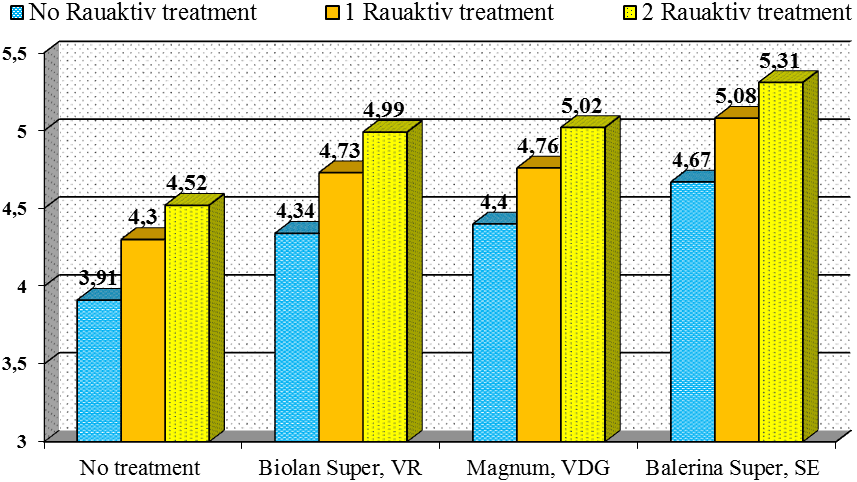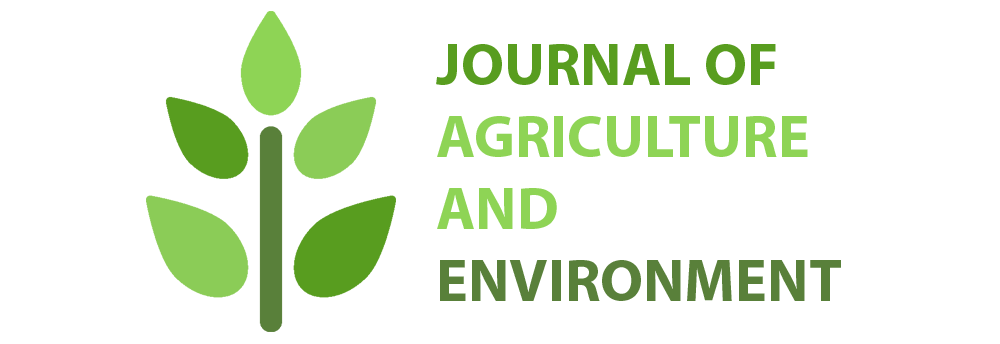ВЫРАЩИВАНИЕ ОЗИМЫХ СОРТОВ ТРИТИКАЛЕ С ИСПОЛЬЗОВАНИЕМ ГЕРБИЦИДОВ И МИКРОУДОБРЕНИЙ В ЦЕНТРАЛЬНОМ НЕЧЕРНОЗЕМЬЕ
ВЫРАЩИВАНИЕ ОЗИМЫХ СОРТОВ ТРИТИКАЛЕ С ИСПОЛЬЗОВАНИЕМ ГЕРБИЦИДОВ И МИКРОУДОБРЕНИЙ В ЦЕНТРАЛЬНОМ НЕЧЕРНОЗЕМЬЕ
Аннотация
В статье представлены результаты трёхлетних исследований по выращиванию озимой тритикале сортов Немчиновский 56 и Триггер в условиях Московской области. В ходе эксперимента было выявлено преимущество применения гербицида Балерина супер, SE – прибавка к необработанному контролю составила 0,72 т/га. Между гербицидами, применяемыми по отдельности, нет существенных различий в показателях средней урожайности озимой тритикале – оба гербицида по сравнению с контролем дают прибавку зерна на 0,40–0,43 т/га. Однократная обработка посевов озимой тритикале Рауактивом по сравнению с необработанным контролем дает среднюю прибавку зерна на 0,37 т/га, а двукратная обработка – на 0,62 т/га. По результатам трехлетних исследований была отмечена высокая урожайность обоих сортов озимой тритикале в условиях Центрального Нечерноземья, которая варьировалась в пределах 4,2–6,0 т/га.
1. Introduction
Winter triticale is a valuable grain crop largely due to the superiority of the parent forms of wheat and rye, higher resistance to weather and soil conditions, high resistance to pests and dangerous diseases , , , .
The chemical composition of triticale is more similar to that of wheat than rye. Some triticale varieties are characterized by a high concentration of lysine, which is a limiting amino acid for grain crops. Triticale is nutrients include starch, non-starch polysaccharides, polyphenols, alkylresorcinols, and vitamins , , .
The utilization of triticale in the baking industry is hindered by the high alpha-amylase activity and weak rheological properties of dough due to low gluten content and its poorer quality in comparison to wheat , .
Increase in the productivity of winter triticale is directly related to the efficient application of fertilizers and agrochemicals. Increases in the grain yield of winter triticale caused by the use of fertilizers on sod-podzolic soil are significant , . In the case of sufficient soil moisture, triticale significantly absorbs mineral fertilizers, especially in combination with the use of foliar feeding of plants , .
When fighting against weeds in agrocenoses, the use of herbicides often leads to adverse effects of varying degrees of severity, which negatively affects the development of agricultural crops and final productivity .
Reduction of the negative impact of herbicide treatments can be achieved by complex application in tank mixture or separately of various growth-stimulating agrochemicals, primarily of organic or organomineral composition . In most cases, these groups of fertilizers have immunomodulatory properties that stimulate the cells of cultivated plants, thereby preventing the negative impact of xenobiotics, which in any volume cause a negative impact on grain crops , , .
Considering that winter grain crops, after overwintering, are quite weak in the early spring period and require many resources for recovery, the use of combined herbicide treatments with organic substances is a very necessary element of agricultural technology. At the same time, knowledge on the combined use of herbicides and agrochemicals based on organic compounds in agrocenoses of winter triticale is insufficient, which determined the direction of our research.
2. Research methods and principles
The experiment was established in Domodedovo district, Moscow region, in the 2021/2022 and 2022/2023 growing years on sod-podzolic soil. Soil content was as follows: pH KCl -5.38; humus -2.23%, P2O5 -157 mg/kg; K2O – 174 mg/kg; N-NO3 -10.3 mg/kg; N-NH4 -2.86 mg/kg.
Winter triticale of Nemchinovsky 56 and Trigger varieties were studied.
After harvesting the predecessor (peas for grain), disking was carried out to a depth of 12-14 cm, then pre-sowing cultivation at 6-8 cm and sowing in the third ten-day period of August in rows at a rate of 5.3 million pcs/ha took place.
The following herbicide treatment options were used in the experiment:
1) no treatment (control);
2) Biolan Super, SE, 0.5 l/ha;
3) Magnum, VDG, 10 g/ha;
4) Balerina super, SE, 0.5 l/ha.
Herbicide spraying was carried out in spring during the tillering phase of the crop and the early growth phases of weeds. Foliar treatment with Rauaktiv at a dose of 1 l/ha was carried out in autumn during the tillering phase and in spring during the tube emergence phase (with double application) and in autumn during the tillering phase (with single application).
Mineral nutrition level (background) N130P40K60 was a calculated level at 50 c/ha, with fractional application in autumn and early spring.
The experiment was laid out according to the method of B.A. Dospekhov and data analysis was performed using program Statistica 10.
3. Results and discussion
In a three-factor field experiment to study the complex action of various herbicides and microfertilizer Rauaktiv in the cultivation of winter triticale varieties, we determined and studied the indicators of the success of plants preservation and loss at different stages of their development (Table 1).
Table 1 - Differences between the average values of survival of triticale plants according to experimental options
Option | 2022 | 2023 | 2024 | In three years | ||||
Average | + to control | Average | + to control | Average | + to control | Average | + to control | |
According to the first order factor (varieties) | ||||||||
Nemchinovsky 56, % | 74.8 | - | 85.1 | - | 86.2 | - | 82.0 | - |
Trigger, % | 79.5 | 4.7 | 88.3 | 3.2 | 87.6 | 1.4 | 85.1 | 3.1 |
For second order factor (herbicide) | ||||||||
No treatment, % | 72.6 | - | 79.1 | - | 82.0 | - | 77.9 | - |
Biolan Super, SV, % | 77.7 | 5.1 | 87.3 | 8.2 | 86.8 | 4.8 | 83.9 | 6.0 |
Magnum, VDG, % | 77.9 | 5.3 | 88.2 | 8.1 | 86.8 | 4.8 | 84.3 | 6.4 |
Balerina super, SE, % | 80.2 | 7.6 | 92.2 | 13.1 | 92.1 | 10.1 | 88.2 | 10.3 |
According to the third order factor (treatment with microfertilizer Rauaktiv) | ||||||||
No treatment, % | 74.4 | - | 81.4 | - | 82.9 | - | 79.6 | - |
Single treatment, % | 77.6 | 3.2 | 87.2 | 5.8 | 87.6 | 4.7 | 84.1 | 4.5 |
Double treatment, % | 79.5 | 5.1 | 91.4 | 10.0 | 90.3 | 7.4 | 87.1 | 7.5 |
Overall in experiment | ||||||||
- | 77.1 | - | 86.7 | - | 86.9 | - | 83.6 | - |
In addition to climatic and soil conditions of the autumn-winter growing season, the third-order factor had also some impact on changes in the wintering rate of winter triticale in studies on the use of herbicides and agrochemicals in cultivating varieties, since in autumn, during the tillering phase, the crops were treated with Rauaktiv at a dose of 1 l/ha. Thus, the wintering rate of winter triticale in options treated with Rauaktiv in the winter of 2021/2022 was +1.7% (LSD05 1.1%) higher than in untreated areas. In other seasons, the difference did not exceed +1% (LSD05 0.7%), while forming a stable trend.
Wintering of triticale in the 2022/2023 season was more difficult, this is due to the low temperature conditions and the lack of snow cover. As a result of which its average indicator decreased by -23.3% compared to the previous season, amounting to only 62.6% on average for the experiment. The winter of 2023/2024 was also quite difficult for wintering of winter triticale plants, here the average wintering value was 75.0%, inferior to the best indicator of 10.5% and more significantly exceeding the worst – by 19.8%.
Regular use of herbicides steadily reduced crop infestation and increased the crop's competitive ability in the fight against weeds, and the second treatment with agrochemical Rauaktiv further increased the survival rate over the years and reduced plant losses in the spring-summer period. If in 2022 the average survival rate was 83.5%, then in 2023 it increased by 3.8% and amounted to 86.7%, and in 2024 it remained at the same level – 86.9%. For the first-order factor (variety), the patterns noted for the previously presented values of field germination and overwintering were confirmed in 2022 and 2024, the survival rate of Nemchinovsky 56 variety was 5.0% and 1.6% higher than that of Trigger variety, and in 2023, on the contrary, Trigger was 3.8% better preserved in the spring-summer period than Nemchinovsky 56.
In 2023, the spring-summer survival rate of the crop increased to the maximum, reaching 92.2% in the option with the use of a herbicid Balerina super, SE, exceeding the untreated control by +16.6%.
The most effective complex effect of the studied chemicals on weed infestation and weed mass was observed when treating winter triticale crops of Nemchinovsky 56 variety with a Balerina super, SE at a dose of 0.5 l/ha in spring during the tillering phase and double treatment of crops with a phytohormonal plant growth stimulator with vitamin-microelement complex Rauaktiv at a dose of 1 l/ha in autumn during the tillering phase and in spring during the tube emergence phase.
On average, according to the experiment, the number of annual weeds was 31.8 pcs/m2, perennial weeds – 2.4 pcs/m2 and the weed mass dropped to 227.0 g/m2. In the best climatic and soil conditions of 2022, these indicators decreased even more intensively, reaching 21.3 pcs/m2 for annual weeds; 2.0 pcs/m2 for perennial weeds and 164.0 g/m2 for weed mass.

Figure 1 - Winter triticale yield depending on the action of herbicides and treatment with Rauaktiv microfertilizer
Note: using Nemchinovsky 56 variety as an example; LSD05 t/ha, ABC for partial differences: 2022 – 0.225; 2023 – 0.266; 2024 – 0.228
The advantage of using a herbicid Balerina super, SE was proven – an increase to the untreated control of 0.72 t/ha (16.9%). There were no significant differences between the herbicides used separately in terms of average yield values of winter triticale – both, in comparison with the control, gave an increase in grain of 0.40–0.43 t/ha (9.4– 9.5%). A single treatment of winter triticale crops with Rauaktiv in comparison with the untreated control gave an average increase in grain of 0.37 (8.6%), and a double treatment – 0.62 t/ha or 14.4%.
4. Conclusion
The use of the specified technological operations led to a significant reduction in crop infestation and weed mass, forming minimum values of all indicators. In the fight against weeds, a herbicid Balerina super, SE at a dose of 0.5 l/ha in the tillering phase in spring was more effective than their separate application. At the same time, an average yield of winter triticale of 4.98 t/ha was formed. Double treatment of crops with phytohormonal plant growth stimulator Rauaktiv at a dose of 1 l/ha in autumn during the tillering phase and in spring during the tube emergence phase led to obtaining the maximum average yield in the experiment of 4.94 t/ha.
